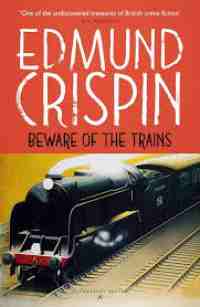Beware of the Trains by Edmund Crispin
 Sunday, February 10, 2019 at 9:45AM
Sunday, February 10, 2019 at 9:45AM 
First published in 1953; republished by Bloomsbury Reader on January 29, 2019
Edmund Crispin was the pen name of Bruce Montgomery, a British mystery writer and musician who did most of his crime writing in the 1940s and 1950s. To give you a sense of his style, here’s a sentence from the story “The Evidence for the Crown”: “This latter circumstance looked like presenting a difficulty, in that Blanche Binney, throttled shortly after lunch one May day on her own sitting-room hearth-rug, was clearly yet another instance of that favourite species of English homicide, the crime passionnel: and there were so many males in Lampoud, married and unmarried, young and old, overt and secretive, who might have resented the catholicity of Blanche’s affections, that the field of suspects seemed at first to be formidably large.” You’ve gotta love mid-century British mysteries.
Somebody chopped off the hand of the lady of dubious repute, and a local constable solves the crime after Crispin steers the reader’s attention away from the culprit. “The Evidence for the Crown” comes near the end of the volume and is one of only two stories that do not feature Oxford Don Gervase Fen and/or Detective Inspector Humbleby.
The other is “Deadlock,” a story told in the first person by a fourteen-year-old boy who is having a midnight adventure when he walks through some blood. A man has been murdered, and in the end, only the boy knows the truth about the murderer’s identity. “Deadlock” is an atmospheric and surprisingly poignant story. It stands as my favorite in the collection.
Another of the volume’s best entries (“The Quick Brown Fox”) explains why criminals are easily captured if they rely on detective stories for inspiration, given the difficulty of pulling off the complex crimes imagined in mysteries. Professor Fen makes good on that theory when he easily solves a murder and an apparent blackmail scheme by spotting the flaw in the murderer’s plan.
Actually, Fen solves most crimes pretty easily. “Beware of the Trains” is like a locked room mystery with a train substituted for the locked room. Nine passengers were riding in groups of three; none of them threw the body from the train. So who did? Humbleby and Fen unravel the mystery.
“Humbleby Agonistes” begins with Humbleby telling Fen about his visit to an old chum who shot at him three times from point blank range and missed. The old chum isn’t bad with a pistol, and in fact had just shot a man in the head in self-defense. Why did the old chum miss? The obvious explanation doesn’t quite make sense to Humbleby, but it takes Fen only a minute to puzzle out the answer.
Fen helps Humbleby resolve another murder, this one involving a love triangle (or maybe a quadrangle) and a seemingly unshakable alibi in “Otherwhere.” The latter story is one of several in which Fen contemplates the relationship between justice and karma.
Fen recounts how he saw through a perfect murder alibi in “Lacrimae Rerum.” He witnesses the murder of a cryptographer in “Within the Gates” and helps the police uncover a corrupt officer. In “Abhorred Shears,” he explains how poison was delivered to a victim in front of several witnesses. His examination of “The Little Room” in a house he is thinking about renting for a charity leads him to suspect (and solve) a crime.
In “Express Delivery,” Fen figures out how a murder was committed (thus proving who committed it) in a case involving suspects who all hoped to inherit from the victim. Fen solves a fairly easy mystery by deducing a robber’s identity in “A Pot of Paint.” In “The Drowning of Edgar Foley,” Fen views a body in the morgue by happenstance and soon discovers who murdered the victim.
Fen shows a bit of a dark side when he explains how a murder involving a missing car was accomplished in “Black for a Funeral,” while Crispin converts a locked room mystery into a ghost story in “The Name on the Window.” In “The Golden Mean,” Fen saves the life of a friend and then, by using a piece of esoteric knowledge, prevents his murder.
The Fen stories are all fairly short. Their brevity leaves little room for character development, although the respective natures of Fen and Humbleby become apparent over time. Fen is astute but a bit arrogant, while Humbleby is an honest plodder. From the days of Holmes and Lestrade, those characteristics have served the characters in British mysteries well. But these stories are about the mysteries more than the characters, and while they vary in quality, the resolutions are generally clever. More importantly, Crispin's leisurely prose style sweeps the reader along, although fans of modern thrillers in which characters are only eloquent when describing their guns might not have the patience to enjoy Crispin’s style.
RECOMMENDED